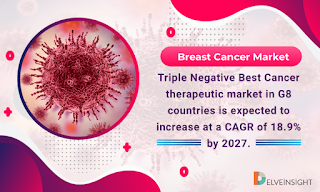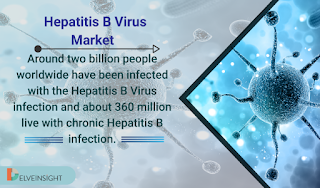Breast Cancer Market Analysis, Market Size, Epidemiology, Leading Companies and Competitive Analysis
About 1 in 8 U.S. women (about
12%) will develop invasive breast cancer over the course of her lifetime,
according to Breast cancer organization. Moreover, the year 2019, an estimated
268,600 new cases of invasive breast cancer are expected to be diagnosed in
women in the U.S., along with 62,930 new cases of non-invasive (in situ) breast
cancer. There are lots of risk factors that can cause Breast Cancer. Around
5-10% of the Breast cancer rates are hereditary and are caused by the transfer
of abnormal genes to offspring. Most of the inherited cancers are caused due to
the mutations in BRCA1 (BReast CAncer gene one) and BRCA2 (BReast CAncer gene
two).
Triple-negative breast cancer is a
rare type of Breast cancer, affecting only about 10 to 20 percent of people
with breast cancer. If a patient gets diagnose with Triple Negative Breast
Cancer it certainly means the absence of expression of estrogen receptor (ER),
progesterone receptor (PR), and human epidermal growth factor receptor 2 (HER2)
amplification/overexpression. DelveInsight’s estimates suggest that the
diagnosed TNBC cases were highest with HER2- expression.
China accounts for 43% of the
total Triple-negative Breast Cancer cases followed by the US which accounts for
24% of the total TNBC diagnosed incident cases, in G8 countries in 2016,
observed DelveInsight, a Healthcare consulting firm. Moreover, the total Triple
Negative Breast Cancer incident cases in the US were estimated to be around
30,285 in the year 2016.
Breast cancer is also diagnosed
in men, as in the year 2019, more than 2,600 men will be diagnosed with Breast
cancer, and approximately 500 men will die from the disease.
Triple-negative breast cancer is
one of the most difficult cancer to treat mainly because of fewer marketed
therapies. Currently, the therapeutic market size of mTNBC in the United States
is mainly accounted by the systemic chemotherapies (either alone or in
combination), such as Paclitaxel (Abraxane), Erbulin (Halaven), Carboplatin,
Cisplatin, Docetaxel etc.
In the year 2018, Lynparza
(Olaparib) developed by AstraZeneca, became the first non-chemotherapy
treatment for patients with an inherited BRCA mutation (also known as gBRCA or
germline BRCA) and HER2-negative metastatic breast cancer, to receive the U.S.
Food and Drugs Administration (USFDA) approval. Although the drug is not
specifically approved for TNBC patients, it still provides a novel treatment
option for mTNBC patients with BRCA mutation, as per DelveInsight’s analysts.
DelveInsight estimates that
Triple Negative Breast Cancer therapeutic market for in G8 Countries is expected
to increase by 2027, at a CAGR of 18.9% for the study period 2016-2027. The
United States accounted for 33% of the total sales in 2016 and is expected to
occupy 37% of the total market by 2027.


Comments
Post a Comment